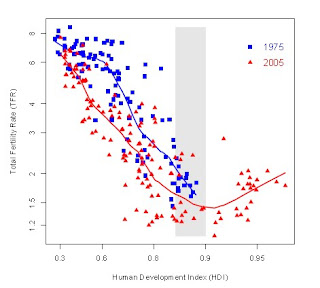The long-held belief in the economic community is that as countries get to be more affluent, their preference for large families declines. This has historically been the case, and the phenomenon has been labelled the demographic shift. Poorer countries aspire to reach it, richer ones dread it. It now appears to tell only half the story.
A recent study published by Dr Mikko Myrskyla from the University of Pennsylvania and his colleagues using repeated cross-country data shows that as countries breach a level of affluence, their ability to have more offspring returns, reversing the demographic shift. This is depicted in the graph below taken from the study.

This graph plots the fertility rate of countries against their HDI or human development index, a measure used by the United Nations which is a composite of per capita income, life expectancy and level of education. The highest value of the index is 1. Back in 1975 Canada scored the highest on this index with 0.89. The kink in the demographic J-curve seems to be around 0.95. Since 1975, more and more countries have breached this threshold, and as a result fertility rates in these countries are now approaching 2 per woman.
This is good news for policy makers in these countries, who previously were forced to project declines in fertility in their indigenous populations and recommend high levels of inmigration just to balance the workforce demands of an aging population. What this study does is point out that with the right set of policies, like the baby bonnus and family friendly work practices, that the fertility decline may be reversed.
This is good news for policy makers in these countries, who previously were forced to project declines in fertility in their indigenous populations and recommend high levels of inmigration just to balance the workforce demands of an aging population. What this study does is point out that with the right set of policies, like the baby bonnus and family friendly work practices, that the fertility decline may be reversed.
No comments:
Post a Comment